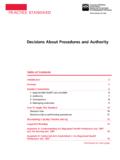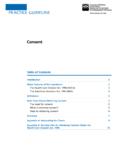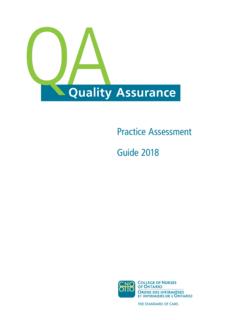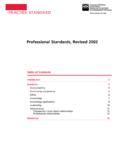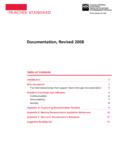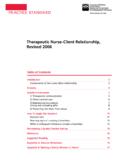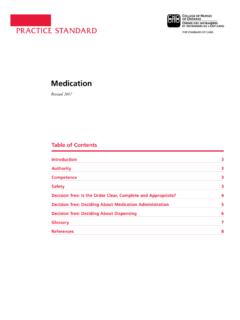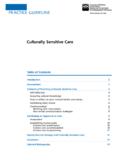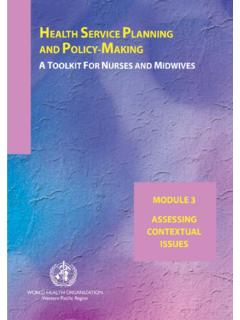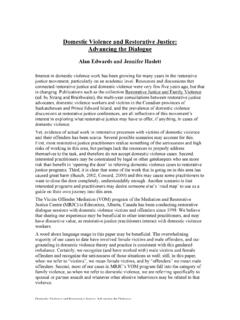Transcription of PRACTICE STANDARD Ethics - CNO
1 PR ACTICE STAndARdTable of Contents Introduction 3 Why an ethical framework? 3A starting point 3 Definitions 3 Ethical Values 4 Types of ethical concerns 4 Resolving ethical conflicts 5 Document layout 5 Client well-being 5 Client choice 6 Privacy and confidentiality 7 Respect for life 8 Maintaining commitments 9 Maintaining commitments to clients 9 Maintaining commitments to oneself 9 Maintaining commitments to nursing colleagues 10 Maintaining commitments to the nursing profession 11 Maintaining commitments to team members/colleagues 12 Maintaining commitments to quality PRACTICE settings 12 Continued on next pageEthicsTable of
2 Contents continuedEthics Pub. No. 41034 ISBN 1-894557-41-7 Copyright College of Nurses of Ontario, or for-profit redistribution of this document in part or in whole is prohibited except with the written consent of CNO. This document may be reproduced in part or in whole for personal or educational use without permission, provided that: Due diligence is exercised in ensuring the accuracy of the materials reproduced; CNO is identified as the source; and The reproduction is not represented as an official version of the materials reproduced, nor as having been made in affiliation with, or with the endorsement of, published March 1999 as Ethical Framework (ISBN 0-921127-65-0)Reprinted January 2000, October 2000, October 2002, Revised for Web June 2003, Reprinted January 2004, December 2005, May 2008.
3 Updated June copies of this document may be obtained by contacting CNO s Customer Service Centre at 416 928-0900 or toll-free in Ontario at 1 800 of Nurses of Ontario 101 Davenport Rd. Toronto, ON M5R fascicule existe en fran ais sous le titre : D ontologie infirmi re, n 51034 Our mIss IO n is to protect the public s right to quality nursing services by providing leadership to the nursing profession in VI sIO n is excellence in nursing PRACTICE everywhere in 13 Fairness 14 Working Through Ethical situations in nursing PRACTICE 14 Assessment/description of situation 15 Plan/approach 15 Implementation/action 15 Evaluation/outcome 15 Conclusion 18selected Bibliography 19PR ACTICE S TAndARd3 College of Nurses of Ontario PRACTICE STANDARD .
4 EthicsNursing standards are expectations that contribute to public protection. They inform nurses of their accountabilities and the public of what to expect of nurses. Standards apply to all nurses regardless of their roles, job description or areas of PRACTICE . College of Nurses of OntarioIntroductionWhy an ethical framework?Consideration of ethical issues is an essential component of providing care within the therapeutic nurse-client relationship. Nurses1 encounter ethical conflict, uncertainty and dis tress in their everyday PRACTICE . Continuous changes in the health care system, in areas such as technology and in values, con tribute to these ethical dilemmas.
5 Understanding and communicating beliefs and values helps nurses to prevent ethical conflicts and to work through them when they do occur. There are many ways to understand and work through ethical starting pointThis document describes the ethical values that are most important to the nursing profession in Ontario. It also provides scenarios of ethical situations in which there is a conflict of values. Nurses are encouraged to use these scenarios for reflection and discussion. No solutions are offered because there is no one solution that is best in all situations.
6 The behavioural directives are intended to help nurses work through ethical situations and provide information about the College of Nurses of Ontario s (CNO s) expectations for ethical conduct. These are taken into account when CNO Committees assess nurses practices. Nurses need to consider behavioural directives carefully when making decisions about ethical care as this process will strengthen their make decisions about ethical situations, nurses need to be aware of their personal values. They need to be knowledgeable of clinical situations and Ethics , and they require the ability to think through a problem and reach a sound decision that they can explain and justify by referring to ethical document is not intended to be a comprehensive guide in nursing Ethics .
7 For more in-depth or specific information, nurses are encouraged to consult with colleagues and persons with expertise in Ethics , and to make use of the selected bibliography at the end of this document. Nurses may also want to enrol in courses in bioethics or health care Ethics . In Ontario, all universities and many community colleges offer such courses. Contact the continuing education, philoso phy or nursing departments for information. Nurses are also encouraged to attend conferences and become involved in Ethics committees and rounds in their settings to continue learning about : Nursing is the therapeutic relationship that enables the client to attain, maintain or regain optimal function by promoting the client s health through assessing, providing care for and treating the client s health conditions.
8 This is achieved by supportive, preventive, therapeutic, palliative and rehabilitative means. The relationship with an individual client may be a direct PRACTICE role or it may be indirect, by means of management, education or research relationship: The therapeutic relationship is established and maintained by the nurse through the nurse s use of professional nursing knowledge, skill, and caring attitudes and behaviours to provide nursing services that contribute to the client s health and well-being. The relationship is based on trust, respect and intimacy and requires the appropriate use of the power inherent in the care provider s role.
9 (For further information, see CNO s Therapeutic Nurse-Client Relationship, Revised 2006 PRACTICE STANDARD .)Caring: In the literature, caring is defined in a number of different ways (Fry, 1994). Caring 1 In this document, nurse refers to a Registered Practical Nurse (RPN), Registered Nurse (RN) and Nurse Practitioner (NP).PR ACTICE S TAndARd4 College of Nurses of Ontario PRACTICE STANDARD : Ethicscan be considered the behaviours , actions and attributes of nurses. Caring nurses listen to and are empathetic with clients points of views. Generally, caring requires the recognition of clients as unique individuals whose goals nurses facilitate.
10 Clients values and choices are of primary consideration when planning and providing care, and a nurse s own personal values must never interfere with the clients right to receive : A client is a person or persons with whom the nurse is engaged in a professional therapeutic relationship. In most circumstances, the client is an individual but in some circumstances (for example, in PRACTICE settings where family-centred care occurs) the client can include family members and/or substitute decision-makers of the individual client. The client may also be a family, a group (for example, therapy) or a community (for example, public health).
